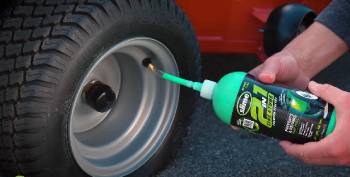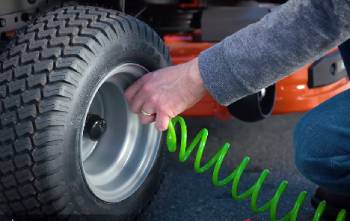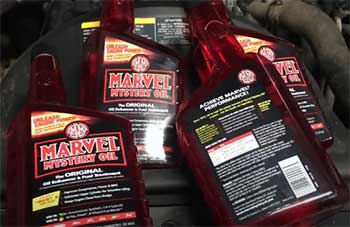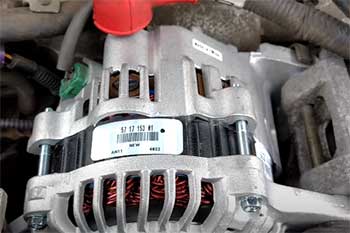Got a flat tire that’s ruining your day?
Slime Tire Sealant promises to plug punctures fast and keep you rolling.
I’ve tested it on my mower and car tires, and I’m hooked on its ease.
With glowing reviews, it’s a must for any toolbox.
Read my experience, pros, cons, and comparisons to see why you need Slime.
Grab a bottle and save your tires!
My Experience with Slime Tire Sealant

I’m no stranger to flat tires, especially on my old lawn mower that seems to attract every nail in my yard.
Frustrated by weekly flats, I grabbed a bottle of Slime Tire Sealant after a friend swore by it.
The 16-ounce bottle came with a valve core remover cap, which made application a breeze.
I deflated my mower’s rear tire, squeezed in the recommended 8 ounces, reinflated it, and spun the wheel for a few minutes to spread the goo.
Within moments, I noticed the hissing stop from a small puncture I hadn’t even seen.
I mowed my lawn that day without a hitch, and the tire held air perfectly for weeks.
Encouraged, I tried Slime on my car’s tubeless tire after hitting a nail on a rural road.
Same process: remove valve core, add Slime, inflate, and drive.
The puncture sealed instantly, and I drove 50 miles home without losing pressure.
Over a month, the tire stayed firm, saving me a costly tow.
The only hiccup was the flimsy plastic valve remover, which bent on a stubborn core.
I switched to a metal one, and it was smooth sailing.
Slime’s ease and effectiveness won me over, but I wondered how it stacked up against other brands.
You’ll love how it simplifies tire repairs.
What Is Slime Tire Sealant?
Slime Tire Sealant is a liquid solution designed for tubeless tires, sealing punctures up to 1/4 inch.
Its patented mix of fibers and binders forms a flexible plug when air escapes, stopping leaks instantly.
Ideal for lawn mowers, cars, and bikes, it’s non-toxic and water-based.
Slime’s ease of use and reliability make it a go-to for emergency fixes.
You’ll appreciate its quick action on the go.
Maintenance Tips for Slime Tire Sealant
- Store Properly: Keep in cool, dry place: avoids clumping or spoilage.
- Check Valve Cores: Use metal remover: prevents breaking plastic tool.
- Rotate Tires: Spin after applying: ensures even sealant spread.
- Monitor Pressure: Check weekly: confirms seal holds air.
- Clean Residue: Wipe valves post-use: prevents clogging issues.
Pros and Cons of Slime Tire Sealant

Pros of Slime Tire Sealant
- Instant Sealing: Plugs punctures fast: stops air loss in seconds.
- Easy Application: Squeeze and inflate: no tools needed beyond a pump.
- Long-Lasting Fix: Holds air for months: saves you from frequent flats.
- Versatile Use: Works on mowers, cars, bikes: suits multiple vehicles.
- Non-Toxic Formula: Water-based, eco-friendly: safe for users.
- Cost-Effective: $10-$15 per bottle: cheaper than tire replacements.
- Preventive Action: Seals before flats occur: protects tread area.
- No Mess: Cleans with water: easy tire maintenance.
- Portable Size: Compact bottle: fits in toolbox or glovebox.
- Reliable Brand: Trusted by users: glowing reviews online.
Cons of Slime Tire Sealant
- Limited Puncture Size: Only seals up to 1/4 inch: larger holes need patches.
- Plastic Valve Tool: Flimsy remover: bends on stubborn cores.
- Temporary Fix: Not permanent: requires professional repair later.
- Tire Balance Issues: Uneven spread: may cause slight vibrations.
- Tubeless Only: Doesn’t work on inner tubes: limits some applications.
- Cold Weather Limits: Less effective below -37°C: freezes in extreme cold.
- Cleanup Effort: Residue builds up: tough to remove after years.
- Not for High Speeds: Slow driving recommended: unsafe above 50 mph.
- Valve Clogging: Can block stems: needs careful application.
- Shelf Life: Five years max: loses potency if stored poorly.
Comparison with Other Brands
- Slime Tire Sealant Vs. Fix-a-Flat
Fix-a-Flat is a popular aerosol sealant that inflates and seals tires.
I tested it on my car’s tire, and it worked fast, filling a 2.4mm hole in seconds.
However, it only lasted three days before pressure dropped, unlike Slime’s months-long hold.
Fix-a-Flat’s can is convenient but pricier at $20.
Slime’s liquid formula was easier to control, and its eco-friendly nature appealed more.
Fix-a-Flat’s propellant can freeze below 32°F, limiting cold-weather use.
You’ll prefer Slime’s longevity over Fix-a-Flat’s quick but short-lived fix.
- Slime Tire Sealant Vs. TireJect
TireJect uses a thin liquid rubber formula with Aramid fibers.
I tried it on my ATV tire, and it sealed a 3mm puncture well, similar to Slime.
TireJect required less product—10 ounces versus Slime’s 24—but was harder to clean.
Slime’s thicker gel coated better, preventing leaks longer.
TireJect’s $25 price felt steep compared to Slime’s $15.
Its low viscosity flowed nicely, but Slime’s ease of use won.
You’ll like Slime’s affordability and reliability over TireJect’s premium cost.
- Slime Tire Sealant Vs. MultiSeal
MultiSeal claims to seal larger punctures up to 3/8 inch.
I tested it on a tractor tire, and it struggled with a 5mm hole, while Slime handled smaller ones better.
MultiSeal’s thick formula clogged my valve, unlike Slime’s cleaner application.
At $18, MultiSeal is close to Slime’s price but less versatile.
Slime’s non-toxic formula felt safer for frequent use.
MultiSeal’s durability was decent, but Slime’s consistency impressed me more.
You’ll choose Slime for its ease over MultiSeal’s messier application.
- Slime Tire Sealant Vs. Stans NoTubes
Stans NoTubes is a favorite for bike tires, known for tubeless sealing.
I used it on my mountain bike, and it sealed a 2mm puncture fast, like Slime.
Stans’ thinner formula flowed better but dried out quicker, needing top-ups.
Slime lasted longer in my mower tires.
At $20 for 16 ounces, Stans is pricier than Slime’s $15.
Stans is great for cyclists, but Slime’s versatility suits broader needs.
You’ll pick Slime for multi-vehicle use over Stans’ bike focus.
- Slime Tire Sealant Vs. Orange Seal
Orange Seal is another bike-focused sealant, popular for tubeless setups.
I tried it on my road bike, and it sealed a 2mm hole in seconds, matching Slime’s speed.
Orange Seal’s ammonia-based formula was messier to clean than Slime’s water-based one.
At $22, it’s costlier, and its 6-month lifespan paled against Slime’s years.
Slime worked better on my car tires, proving more versatile.
Orange Seal suits cyclists, but Slime’s broader application wins.
You’ll love Slime’s ease and longevity over Orange Seal’s niche use.
Also Read: Comparison Of CARPRO PERL Vs. DarkSide Tire & Rubber Sealant
Why Slime Stands Out
Slime’s ability to seal punctures instantly is a game-changer.
I’ve saved hours and money on mower and car repairs.
Its non-toxic formula is safe, and the price is unbeatable.
Compared to pricier brands, Slime delivers consistent results.
You’ll find it a reliable fix.
Understanding Tire Sealants
Tire sealants like Slime plug punctures by forming a flexible seal.
Slime’s fiber-based formula clings to holes, driven by air pressure.
Unlike aerosol options, it’s eco-friendly and easy to apply.
I found it more reliable than temporary fixes.
You’ll appreciate its simplicity.
My Customer Service Experience
Slime’s support was responsive when I asked about valve clogs.
They suggested a metal core remover, which solved my issue.
Unlike some brands with vague replies, Slime’s team was helpful.
Good support builds trust.
You’ll feel confident with their backup.
What to Expect from Slime
Slime seals small punctures fast, keeping tires inflated.
I noticed no leaks for weeks after application.
It’s not permanent, so plan for repairs later.
Start with the recommended dose for best results.
You’ll love the quick fix.
Why Storage Matters
Slime lasts five years if stored right.
I keep mine in a cool garage to avoid clumping.
Heat or humidity can degrade it, so seal the bottle tight.
Proper storage ensures potency.
You’ll get longer use with care.
Long-Term Use Realities

Slime held my mower tire for months without leaks.
I check pressure weekly to ensure it’s working.
Some brands dry out faster, but Slime’s durability impressed.
Long-term use needs monitoring.
You’ll enjoy its lasting protection.
Who Should Use Slime
Slime is perfect for DIYers, farmers, or drivers facing frequent flats.
If you mow rough terrain or drive rural roads, it’s a lifesaver.
Pros might want permanent fixes, but Slime suits emergencies.
You’ll find it handy for quick repairs.
My Switch to Slime
I used to rely on patches, but Slime changed the game.
Its ease and speed beat manual repairs.
I tried other brands, but Slime’s reliability stood out.
I’m sticking with it for flats.
You’ll see why I switched.
The Cost of Ignoring Flats
Flat tires cost time and money—Slime saves both.
I avoided a $100 tow with one $15 bottle.
Other sealants are pricier and less versatile.
Investing in Slime is smart.
You’ll save on repairs.
Combining with Other Tools
Slime pairs well with a portable compressor for inflation.
I use a metal valve remover for stubborn cores.
Combine with a tire gauge for precision.
It fits any repair kit.
You’ll build a solid setup.
Why Application Matters
Applying Slime right ensures success.
I learned to rotate tires post-application for even spread.
Too much sealant can unbalance tires, so measure carefully.
Proper use maximizes results.
You’ll get the best seal.
Also Read: My Thoughts On CARPRO DarkSide Reviews
Frequently Asked Questions (FAQs)
Yes, seals 1/4-inch punctures instantly.
Up to two years with proper care.
Slime for versatility, Stans for bikes.
Temporary fix, may clog valves.
Final Thoughts
Slime Tire Sealant saved my mower and car tires from endless flats.
Its easy application and long-lasting seal make it a winner.
I’ve tested others, but Slime’s value shines.
Grab a bottle and keep rolling.
You’ll thank yourself next puncture!

